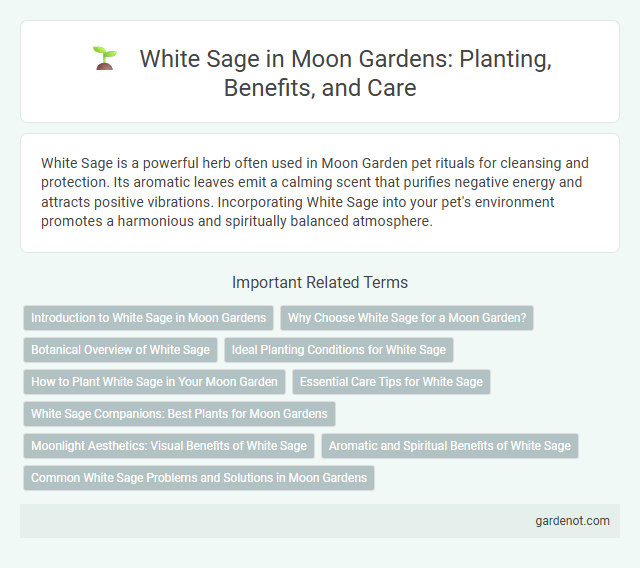White Sage is a powerful herb often used in Moon Garden pet rituals for cleansing and protection. Its aromatic leaves emit a calming scent that purifies negative energy and attracts positive vibrations. Incorporating White Sage into your pet's environment promotes a harmonious and spiritually balanced atmosphere.
Introduction to White Sage in Moon Gardens
White Sage (Salvia apiana) thrives in moon gardens due to its silvery-white foliage that reflects moonlight, enhancing nighttime visibility and creating a mystical ambiance. This drought-tolerant plant produces fragrant leaves, traditionally used for cleansing and spiritual purposes, adding a sensory experience to the garden. White Sage's structural form and soft texture complement other moon garden plants like lamb's ear and silver thyme, reinforcing the serene, ethereal aesthetic.
Why Choose White Sage for a Moon Garden?
White Sage thrives in moon gardens due to its silvery foliage that reflects moonlight, creating a luminous and ethereal ambiance. Known for its cleansing properties, White Sage purifies the air and spiritual energy, enhancing the garden's tranquility. Its drought-tolerant nature ensures low maintenance while providing a fragrant, mystical experience under the night sky.
Botanical Overview of White Sage
White sage (Salvia apiana) is a woody shrub native to the southwestern United States and northwestern Mexico, known for its silvery-green, aromatic leaves and white flowers. This perennial plant thrives in dry, sandy soils and full sunlight, reaching heights of up to 3 feet. White sage is widely recognized for its traditional use in smudging rituals and natural pest repellents, making it a significant botanical species in moon garden designs.
Ideal Planting Conditions for White Sage
White Sage (Salvia apiana) thrives best in well-drained, sandy or rocky soils with full sun exposure, replicating its native arid habitats in the southwestern United States. It requires minimal watering once established, as overwatering can cause root rot. Optimal growth occurs in USDA hardiness zones 8 to 11, with temperatures ranging from 50 to 85degF (10 to 29degC).
How to Plant White Sage in Your Moon Garden
Plant white sage in your Moon Garden by choosing well-drained, sandy soil in a sunny location with at least 6 hours of direct sunlight daily. Space white sage plants 18 to 24 inches apart to ensure adequate air circulation, and water sparingly to prevent root rot, as white sage thrives in dry conditions. Incorporate organic matter into the soil before planting to improve fertility and encourage strong root development for optimal growth in your Moon Garden.
Essential Care Tips for White Sage
White Sage thrives in well-drained soil with full sun exposure and moderate watering, avoiding waterlogged conditions to prevent root rot. Regular pruning encourages bushier growth and prevents the plant from becoming leggy, while harvesting should be done carefully to preserve the plant's natural shape. Ensuring good air circulation around the plant and using organic fertilizers during the growing season supports healthy development and vibrant leaves.
White Sage Companions: Best Plants for Moon Gardens
White Sage thrives alongside lavender, which enhances its drought tolerance and attracts pollinators, creating a harmonious moon garden display. Silver Artemisia complements White Sage with its silvery foliage, amplifying the garden's ethereal, moonlit aesthetic. Planting these companions together optimizes soil conditions and supports beneficial insects, ensuring a vibrant and sustainable moon garden.
Moonlight Aesthetics: Visual Benefits of White Sage
White Sage enhances moon garden aesthetics by reflecting moonlight, creating a soft, silvery glow that elevates nighttime ambiance. Its pale green leaves possess a subtle luminosity that complements lunar illumination, intensifying the mystical atmosphere of moonlit landscapes. This visual benefit makes White Sage an ideal addition for gardeners seeking to amplify the ethereal beauty of their moon gardens.
Aromatic and Spiritual Benefits of White Sage
White Sage, known scientifically as Salvia apiana, offers powerful aromatic benefits that purify the air and create a calming atmosphere in the Moon garden. Its sacred smoke has been used for centuries in spiritual rituals to cleanse negative energy and promote healing. The herb's rich, earthy scent enhances meditation, mindfulness, and emotional balance, supporting a deeper connection to nature and the self.
Common White Sage Problems and Solutions in Moon Gardens
White Sage in moon gardens often faces common issues such as powdery mildew, root rot, and pest infestations like spider mites. Prevent powdery mildew by ensuring good air circulation and avoiding overhead watering, while root rot can be controlled by planting in well-draining soil and reducing excess moisture. Spider mites can be managed with regular misting and natural insecticidal sprays, promoting a healthy and thriving White Sage in your moon garden.
White Sage Infographic

 gardenot.com
gardenot.com